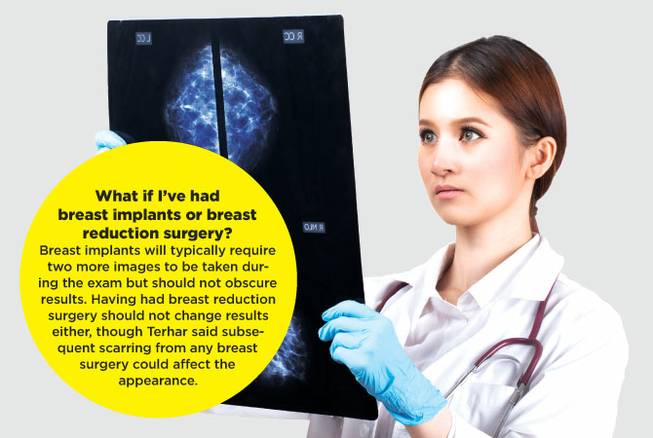
Monday, Sept. 18, 2017 | 2 a.m.
The American Cancer Society estimates that there will be about 252,710 new cases of invasive breast cancer diagnosed this year in the United States. Further, the National Cancer Institute reports that 12.4 percent of women will develop breast cancer at some point in their lifetime.
Aside from skin cancers, breast cancer is the most common type of cancer for women in the U.S. and, while it cannot be prevented, it’s often treatable when discovered early.
Mammograms are the best screening method available for detecting breast cancer and, because of this, committing to a regular mammogram schedule can be lifesaving. While the procedure may feel uncomfortable for some, being prepared can help demystify the process.
Who needs mammograms and how often?
All women should discuss getting a mammogram with her doctor once she turns 40. Depending on the woman’s medical history and risk factors, her doctor can help give a personalized recommendation for what mammogram frequency is best. Oftentimes, it’s recommended that women get a mammogram every year after age 40, but some women with high-risk factors may need to start earlier or go more frequently.
Women who notice any sudden change in their breasts should mention it to their doctor as well, because it may require a diagnostic mammogram. Sudden changes that may indicate a problem include noticeable lumps/dimpling, nipple inversion and nipple discharge.
The mammogram process and what to expect
1. You’ll be given a gown to change into for the top half of your body. You should then have an opportunity to talk to your radiologist about any questions or concerns before beginning the exam.
2. During the exam, each breast is sandwiched between two plates on the imaging device. Plates will compress/flatten the breasts as much as possible, and without causing any excessive discomfort.
3. The device then takes a low-dose X-ray of the breast tissue to detect any abnormalities.
“Generally, the process takes about 20-30 minutes,” said Margaret Terhar, MD, FACS, Medical Director of the Breast Center at Sunrise Hospital and Medical Center. Typically, the technologist takes two images of each breast, but women with dense breasts, implants or a medical history may require more.
Results are usually available within 24 to 48 hours, but patient notification may take longer depending on the clinic and mailing service.
How to prepare for a mammogram
Jane Durham, ARRT, radiologic technologist at Red Rock Radiology, a department of MountainView Hospital, recommends that women avoid wearing deodorant, powders, lotions and creams on the breasts and underarm area prior to their mammogram. Further, “it is best to wear a two-piece outfit because you’ll be undressing from the waist up,” Durham said. “Leave neck jewelry and earrings at home.”
Women whose breasts are especially sensitive may want to take acetaminophen before the exam to help alleviate discomfort. However, taking aspirin may cause and/or increase bruising.
It may also be a good idea to bring any past mammogram results and images if possible — particularly if you’re going to a new facility for your imaging. “If you’re going to a new facility, bring a copy of the images on CD from your last mammogram and give it to your radiologist for comparison,” said Staci McHale, MD, OB/GYN at Southern Hills Hospital and Medical Center.
Does it hurt?
Most women have no pain. It may be uncomfortable, but the level of discomfort depends on the person. It may be helpful for some to plan the appointment around their menstruation cycle. “Try to avoid having a mammogram immediately before or during your cycle,” Terhar said.
What if I’ve recently given birth and/or am breastfeeding?
“Changes in the breasts that occur during breastfeeding can make mammograms much more difficult to interpret,” McHale said. Because of this, Terhar recommends considering other screening options, including ultrasound, for women who are breastfeeding and simultaneously experiencing possible breast cancer symptoms.
What if I’m on hormone replacement therapy (HRT)?
“HRT can increase the density of the breasts and make mammograms less sensitive,” Terhar said. Collaborate closely with your doctor while taking HRT treatment and discuss any upcoming mammograms with him or her. Durham recommends making sure that your technologist knows you’re taking HRT.
What if I’ve had breast implants or breast reduction surgery?
Breast implants will typically require two more images to be taken during the exam but should not obscure results. Having had breast reduction surgery should not change results either, though Terhar said subsequent scarring from any breast surgery could affect the appearance.
What if I have nipple piercings?
Take the jewelry out prior to the appointment.
What if I am a transgender woman?
Any woman with breast tissue should get mammograms. “If you’re taking HRT, you have similar risks,” Terhar said.
At what age should I stop getting regular mammograms?
This is something you should discuss with your doctor, but as long as your health is good enough to have cancer treatment, you should maintain screenings.

Join the Discussion:
Check this out for a full explanation of our conversion to the LiveFyre commenting system and instructions on how to sign up for an account.
Full comments policy